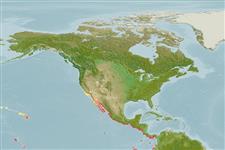Environment: milieu / climate zone / depth range / distribution range
Ecologia
marino; acqua dolce; salmastro demersale; pH range: 7.5 - 9.5; amfidromo (Ref. 51243); distribuzione batimetrica 1 - ? m. Subtropical; 25°C - 33°C (Ref. 36880); 41°N - 0°S
Eastern Pacific: Palos Verdes in southern California, USA to Peru.
Length at first maturity / Size / Peso / Age
Maturity: Lm ?, range 17 - ? cm
Max length : 41.0 cm TL maschio/sesso non determinato; (Ref. 5404); 39.0 cm TL (female); common length : 25.0 cm TL maschio/sesso non determinato; (Ref. 55763); peso massimo pubblicato: 1.2 kg (Ref. 5404); peso massimo pubblicato: 1.2 kg
Short description
Chiavi di identificazione | Morfologia | Morfometria
Body compressed; head flat; first dorsal fin with 7 spines, second with 1 spine and 8 to 9 rays; anal fin with 1 spine and 9 to 10 rays; lateral line with 30 to 34 scales; body depth contained about three times in standard length; body dark green to dark brown with numerous small pale spots (Ref. 55763).
Facultative air-breathing (Ref. 126274); Inhabit estuaries, stagnant ditches or creeks of low current velocity between the sea and an elevation of 30 m. Benthic and most abundant on sandy and muddy bottoms. Ingests much mud and detritus, although also filter plankton (Ref. 36880). Found in shallow inshore areas; typically in freshwater but moves freely into the sea.
Life cycle and mating behavior
Maturità | Riproduzione | Deposizione | Uova | Fecundity | Larve
Eschmeyer, W.N., E.S. Herald and H. Hammann, 1983. A field guide to Pacific coast fishes of North America. Boston (MA, USA): Houghton Mifflin Company. xii+336 p. (Ref. 2850)
IUCN Red List Status (Ref. 130435: Version 2024-2)
Threat to humans
Harmless
Human uses
Pesca: commerciale; Acquacoltura: commerciale
Strumenti
Special reports
Download XML
Fonti Internet
Estimates based on models
Preferred temperature (Ref.
123201): 22.3 - 29.1, mean 26.8 °C (based on 208 cells).
Phylogenetic diversity index (Ref.
82804): PD
50 = 0.5312 [Uniqueness, from 0.5 = low to 2.0 = high].
Bayesian length-weight: a=0.01023 (0.00757 - 0.01383), b=3.11 (3.03 - 3.19), in cm total length, based on LWR estimates for this species (Ref.
93245).
Trophic level (Ref.
69278): 2.0 ±0.0 se; based on diet studies.
Generation time: 1.9 ( na - na) years. Estimated as median ln(3)/K based on 1
growth studies.
Resilienza (Ref.
120179): Alto, tempo minimo di raddoppiamento della popolazione meno di 15 mesi (K=0.57).
Fishing Vulnerability (Ref.
59153): Low to moderate vulnerability (25 of 100).
Nutrients (Ref.
124155): Calcium = 118 [54, 257] mg/100g; Iron = 1.24 [0.59, 2.45] mg/100g; Protein = 18.7 [16.7, 20.4] %; Omega3 = 0.278 [0.165, 0.480] g/100g; Selenium = 20.8 [10.3, 46.6] μg/100g; VitaminA = 7.09 [2.13, 23.95] μg/100g; Zinc = 1.28 [0.88, 2.08] mg/100g (wet weight);
